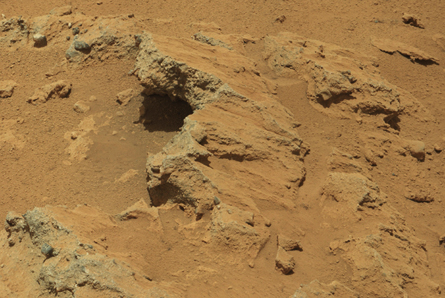It seems NASA chose the Curiosity rover’s destination wisely: The craft appears to have landed right in an ancient streambed. Tasked with searching for signs of life-friendly environments on Mars, the rover can now cross off “find evidence for water” from its life-friendly to-do list, NASA announced in a press conference September 27.

NASA sent Curiosity to Gale Crater because data from orbiting spacecraft suggested the site had a good chance of having once been wet. Still, the speed with which the discovery came seems to have surprised the team.
“It is exactly the reason we chose this landing site,” said project scientist John Grotzinger of Caltech.
The best evidence for ancient rushing water comes from the rocks Curiosity has paused to investigate while wheeling toward Mount Sharp, an enormous pile of sediment rising from the crater’s center. These rocks, called conglomerates, are made of pebbles cemented together by once-wet sediments.
In other words, they’re rocks made of rocks.
Curiosity glimpsed its first conglomerate at the landing site, where retrorocket engines dusted off the planet’s reddish veneer and revealed the speckled bedrock beneath. “There’s a layer there that seems to have rocks embedded in it,” said Mike Malin of Malin Space Science Systems in San Diego. The feature is now named “Goulburn,” after geologic deposits in northern Canada.
Then, after stretching its wheels, the rover encountered another site called “Link,” where more conglomerate rocks were found. The pebbles there and elsewhere point toward a watery transport mechanism, said Rebecca Williams of the Planetary Science Institute in Tucson, Ariz. Smooth and polished, roughly 1 centimeter across — the size of a plain M&M candy — the pebbles couldn’t have been transported by anything except water. “These are too large to be transported by wind,” Williams said. “The consensus is that these are water-transported gravels.”
Eventually, the rover found a rock called Hottah (named for a Canadian lake), which juts out of the Martian dust at an angle, jagged edges pointed skyward. “To us, it just looked like somebody came along the surface of Mars with a jackhammer and lifted up a sidewalk,” Grotzinger said.
The 10- to 15-centimeter thick outcrop was once submerged, he said. “And we can characterize that water as being a vigorous flow, on the surface of Mars.”
The interpretation is robust, says geologist Joseph Michalski, also of the Planetary Science Institute. “There aren’t very many ways by which you can produce rounded pebbles like that.”
But the water’s source — whether melting ice, rainfall, or groundwater — and its duration on the surface are still open questions.
Scientists think the Martian streambed grew from a canyon that funneled water into Gale Crater. Roughly 18 kilometers long, about 600 meters across and 30 meters deep, the canyon — called Peace Vallis — cut into the crater rim, sweeping sediments to the crater floor and forming a floodplain. Had Curiosity landed roughly 3.5 billion years ago, she might have found herself in a stream, “from ankle to hip deep, and maybe moving a few feet a second,” said William Dietrich of the University of California, Berkeley.
And while large, rounded pebbles certainly point to fast-flowing water, they don’t indicate anything about the flow’s duration, Michalski says. “You may have had punctuated activity, or it could have been sustained for a shorter period,” he says. “It doesn’t mean that it had to stay wet for millions of years.”
So, is it mission accomplished? Game over for the rover?
Not quite.
The rover is still tasked with searching for signs of a life-friendly environment, and with exploring the rocky record contained in the layers of Mount Sharp. In addition to water, the rover will look for organic carbon — from which life could be built — and molecules that could serve as an energy source. “We’ve got a hall pass for the water observation,” Grotzinger said. “Now we’re going to move on to the chemical building blocks of life and the elemental chemistry and the mineralogy.”







